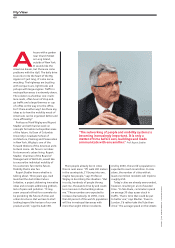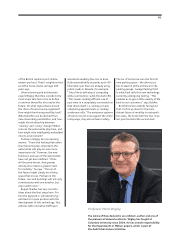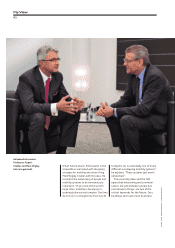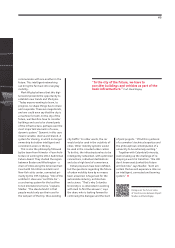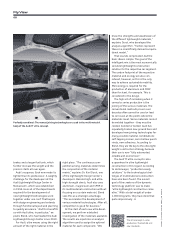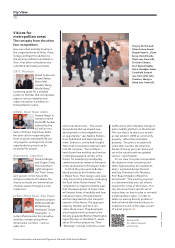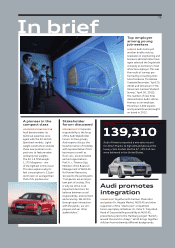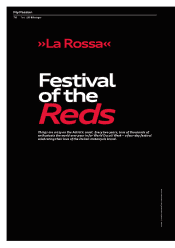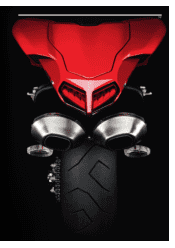Audi 2012 Annual Report Download - page 71
Download and view the complete annual report
Please find page 71 of the 2012 Audi annual report below. You can navigate through the pages in the report by either clicking on the pages listed below, or by using the keyword search tool below to find specific information within the annual report.
brakes and a larger fuel tank, which
further increase the weight and the
process starts all over again.
Audi’s response: Each new model is
lighter than its predecessor. A weighty
challenge for the developers at the
Audi Lightweight Design Center in
Neckarsulm, which was established
in 1994. Here all of the departments
required for the development of
new lightweight technologies work
together under one roof. That begins
with design engineering and extends
through functional layout and planning
to quality assurance. “And this benefits
us with Audi ultra, in particular,” ex-
plains Elend, who has headed the Audi
Lightweight Design Center since 2010.
For Audi, ultra means using the right
amount of the right material in the
know the strengths and weaknesses of
the dierent lightweight materials,”
explains Durst, who developed the
analysis algorithm. “Factors represent
these in a scientifically derived computa -
tional model.”
That sounds complicated, but the
basic idea is simple. The goal of the
intelligent mix is the most economically
sensible lightweight construction
solution for the respective car segment.
The carbon footprint of the respective
material and ecology are also con-
sidered, however, as this is the only
way to achieve sustainable mobility.
More energy is required for the
production of aluminum and CFRP
than for steel, for example. This is
considered in the design.
The high art of carmaking when it
comes to series production is the
joining of the various materials. The
conventional methods proven over
decades often cannot be used or lead
to corrosion at the points where the
materials meet. Some materials cannot
be welded together – they must be
riveted, bonded or bolted. Audi has
repeatedly broken new ground here and
developed new joining technologies for
many possible material combinations:
self-tapping screws, semi-hollow punch
rivets, new adhesives. According to
Elend, they are the key to the ultra light -
weight construction strategy because
their use is now “fully automated,
reliable and economical.”
The Audi TT ultra concept is also
a spearhead in ultra lightweight
construction in this regard. According
to Hollerweger, “production-ready
solutions” to the technological chal-
lenges of multimaterial construction
have also been found. The overall
goal of the creators of the dynamic
technology platform was to make
“ultra lightweight construction come
alive.” With a total weight of under
1,000 kilograms, they have done that
quite impressively. «
right place. “The continuous com-
petition among materials determines
the composition of the material
matrix,”
explains Dr. Karl Durst, one
of the Light weight Design Center’s
developers. Besides high- and ultra-
high-strength steels, Audi also uses
aluminum, magnesium and CFRP in
its multimaterial con struc tion without
focusing on a certain material. Elend
sees this as a strategic advantage.
“This accel er ates the development of
various material tech nologies. After all,
compe tition is good for business.”
At the start of each new ultra devel -
opment, we perform a detailed
investigation of the materials available.
The results are input into an analysis
algorithm used to assign the optimal
material for each component. “We
Perfectly combined: The newest joining technologies are used in the multimaterial
body of the Audi TT ultra concept.
The ultra concept in series
production: The Audi A6 sets
new standards.
P H O T O S | P I C T U R E -S E RV I C E G M B H ; J I M R A K E T E
My View
68




